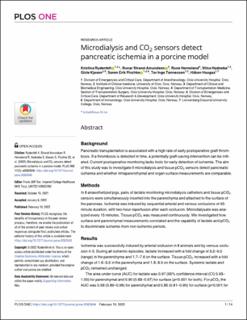| dc.contributor.author | Rydenfelt, Kristina Elisabeth | |
| dc.contributor.author | Strand-Amundsen, Runar James | |
| dc.contributor.author | Horneland, Rune | |
| dc.contributor.author | Hødnebø, Stina | |
| dc.contributor.author | Kjøsen, Gisle | |
| dc.contributor.author | Pischke, Soeren | |
| dc.contributor.author | Tønnessen, Tor Inge | |
| dc.contributor.author | Haugaa, Håkon | |
| dc.date.accessioned | 2023-02-15T08:58:36Z | |
| dc.date.available | 2023-02-15T08:58:36Z | |
| dc.date.created | 2022-05-20T08:37:39Z | |
| dc.date.issued | 2022 | |
| dc.identifier.citation | Rydenfelt K, Strand-Amundsen R, Horneland R, Hødnebø S, Kjøsen G, et al. (2022) Microdialysis and CO2 sensors detect pancreatic ischemia in a porcine model. PLOS ONE, 17(2). | en_US |
| dc.identifier.issn | 1932-6203 | |
| dc.identifier.uri | https://hdl.handle.net/11250/3050937 | |
| dc.description.abstract | Background: Pancreatic transplantation is associated with a high rate of early postoperative graft thrombosis. If a thrombosis is detected in time, a potentially graft-saving intervention can be initiated. Current postoperative monitoring lacks tools for early detection of ischemia. The aim of this study was to investigate if microdialysis and tissue pCO2 sensors detect pancreatic ischemia and whether intraparenchymal and organ surface measurements are comparable.
Methods: In 8 anaesthetized pigs, pairs of lactate monitoring microdialysis catheters and tissue pCO2 sensors were simultaneously inserted into the parenchyma and attached to the surface of the pancreas. Ischemia was induced by sequential arterial and venous occlusions of 45-minute duration, with two-hour reperfusion after each occlusion. Microdialysate was analyzed every 15 minutes. Tissue pCO2 was measured continuously. We investigated how surface and parenchymal measurements correlated and the capability of lactate and pCO2 to discriminate ischemic from non-ischemic periods.
Results: Ischemia was successfully induced by arterial occlusion in 8 animals and by venous occlusion in 5. During all ischemic episodes, lactate increased with a fold change of 3.2–9.5 (range) in the parenchyma and 1.7–7.6 on the surface. Tissue pCO2 increased with a fold change of 1.6–3.5 in the parenchyma and 1.3–3.0 on the surface. Systemic lactate and pCO2 remained unchanged.
The area under curve (AUC) for lactate was 0.97 (95% confidence interval (CI) 0.93–1.00) for parenchymal and 0.90 (0.83–0.97) for surface (p<0.001 for both). For pCO2 the AUC was 0.93 (0.89–0.96) for parenchymal and 0.85 (0.81–0.90) for surface (p<0.001 for both). The median correlation coefficients between parenchyma and surface were 0.90 (interquartile range (IQR) 0.77–0.95) for lactate and 0.93 (0.89–0.97) for pCO2.
Conclusions: Local organ monitoring with microdialysis and tissue pCO2 sensors detect pancreatic ischemia with adequate correlation between surface and parenchymal measurements. Both techniques and locations seem feasible for further development of clinical pancreas monitoring. | en_US |
| dc.language.iso | eng | en_US |
| dc.rights | Navngivelse 4.0 Internasjonal | * |
| dc.rights.uri | http://creativecommons.org/licenses/by/4.0/deed.no | * |
| dc.subject | Postoperativ sykepleie | en_US |
| dc.title | Microdialysis and CO2 sensors detect pancreatic ischemia in a porcine model | en_US |
| dc.type | Peer reviewed | en_US |
| dc.type | Journal article | en_US |
| dc.description.version | publishedVersion | en_US |
| dc.rights.holder | © The Author(s) 2022. | en_US |
| dc.source.volume | 17 | en_US |
| dc.source.journal | PLOS ONE | en_US |
| dc.source.issue | 2 | en_US |
| dc.identifier.doi | 10.1371/journal.pone.0262848 | |
| dc.identifier.cristin | 2025831 | |
| dc.source.articlenumber | e0262848 | en_US |
| cristin.ispublished | true | |
| cristin.fulltext | original | |
| cristin.qualitycode | 1 | |

